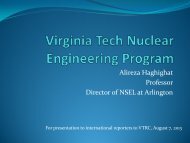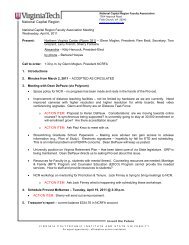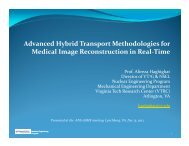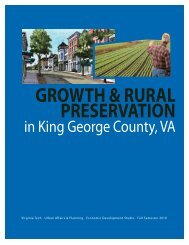Graduate Education in the National Capital Region - NCR Faculty ...
Graduate Education in the National Capital Region - NCR Faculty ...
Graduate Education in the National Capital Region - NCR Faculty ...
Create successful ePaper yourself
Turn your PDF publications into a flip-book with our unique Google optimized e-Paper software.
collaborat<strong>in</strong>g with WMATA, <strong>the</strong> agency that runs <strong>the</strong> DC Metro. Programs <strong>in</strong> Marriageand Family Therapy work extensively with military families; ALHRD offers professionaldevelopment opportunities to federal employees, peer <strong>in</strong>stitutions, and communityorganizations; <strong>Education</strong> works with <strong>the</strong> local county school systems – some of <strong>the</strong> best <strong>in</strong><strong>the</strong> country; and programs <strong>in</strong> Science and Technology Studies, Natural Resources, <strong>the</strong>Center for Public Adm<strong>in</strong>istration and Policy, Bus<strong>in</strong>ess, and o<strong>the</strong>rs rely extensively on <strong>the</strong>region’s bus<strong>in</strong>ess and government professionals to serve as adjunct faculty, expert panels,and collaborators, <strong>in</strong> some cases (e.g., ALHRD) engag<strong>in</strong>g professionals on dissertationcommittees.The region is both a real-world laboratory <strong>in</strong> which students can directly apply and test<strong>the</strong>ir knowledge as part of <strong>the</strong>ir studies, and a source for unique perspectives, adjunctfaculty, professors <strong>in</strong> practice, and student engagement opportunities.Community Identity <strong>in</strong> <strong>the</strong> <strong>NCR</strong>One of <strong>the</strong> most vex<strong>in</strong>g problems for our graduate programs <strong>in</strong> <strong>the</strong> <strong>NCR</strong> is develop<strong>in</strong>g <strong>the</strong>critical mass upon which to base a sense of community. Most of our graduate students areadult, part-time learners, and our facilities are geographically dispersed. There is no timeat which all our students congregate, nor is <strong>the</strong>re a facility at which this could happen.Our students, <strong>the</strong>refore, may have a strong sense of belong<strong>in</strong>g to <strong>the</strong>ir program and sharecamaraderie with a small set of classmates and faculty, but <strong>the</strong>y tend not to share acommon sense of be<strong>in</strong>g Virg<strong>in</strong>ia Tech community members.Many of our graduate programs have worked hard to build last<strong>in</strong>g ties with <strong>the</strong>ir studentsand to foster a group identity with<strong>in</strong> <strong>the</strong>ir programs. The Marriage and Family Therapyprogram, for example, has made this a priority over <strong>the</strong> years and <strong>the</strong> alumni are extremelypositive about and loyal to <strong>the</strong> program, act<strong>in</strong>g as an effective resource for MFT. TheALHRD program actively encourages student <strong>in</strong>teraction outside of class, provid<strong>in</strong>gopportunities for mentor<strong>in</strong>g by alumni and encourag<strong>in</strong>g students to form mutual supportgroups through monthly ‘drop-<strong>in</strong>’ sessions and virtual meet<strong>in</strong>g places <strong>in</strong> Blackboard forthose writ<strong>in</strong>g <strong>the</strong>ir dissertations.The cohort model used <strong>in</strong> <strong>the</strong> EMBA program is ano<strong>the</strong>r excellent example. The classbonds through hav<strong>in</strong>g all <strong>the</strong>ir classes shared, eat<strong>in</strong>g toge<strong>the</strong>r dur<strong>in</strong>g <strong>the</strong>ir sessions, andtravel<strong>in</strong>g toge<strong>the</strong>r for up to a week at a time. However, <strong>the</strong> EMBA students do not tend to<strong>in</strong>teract with students <strong>in</strong> o<strong>the</strong>r programs.Similarly, <strong>the</strong> Architecture program <strong>in</strong> Alexandria has developed a strong communalidentity with<strong>in</strong> an <strong>in</strong>sular program, <strong>in</strong> this case composed mostly of full-time students.Their program is housed <strong>in</strong> a s<strong>in</strong>gle build<strong>in</strong>g (a real-world lab of its own for <strong>the</strong> program),and <strong>the</strong>y are unique <strong>in</strong> <strong>the</strong> region <strong>in</strong> hav<strong>in</strong>g established a site for student and facultyhous<strong>in</strong>g to accommodate <strong>the</strong>ir <strong>in</strong>ternational students and visit<strong>in</strong>g faculty. Interactionbetween students <strong>in</strong> <strong>the</strong> Architecture program and o<strong>the</strong>r students, however, is m<strong>in</strong>imal.Develop<strong>in</strong>g <strong>the</strong> sense of community exhibited by <strong>the</strong>se programs is <strong>the</strong> ideal. The questionis whe<strong>the</strong>r it requires a physical facility where faculty and student from all programs5
out<strong>in</strong>ely congregate or identify with and call “home.” As Virg<strong>in</strong>ia Tech expands <strong>in</strong> <strong>the</strong>region, for example, build<strong>in</strong>g an advanced research facility that will house approximately150 faculty and <strong>the</strong>ir graduate students <strong>in</strong> Ballston, we take steps toward that ideal <strong>in</strong> onesense, but we also move away from <strong>the</strong> hope of a campus-like feel<strong>in</strong>g that might haveevolved if <strong>the</strong> new facility had been built adjacent to <strong>the</strong> current Nor<strong>the</strong>rn Virg<strong>in</strong>ia Centeror <strong>the</strong> programs <strong>in</strong> Alexandria.It seems most practical to focus efforts not on a s<strong>in</strong>gle physical location for Virg<strong>in</strong>ia Tech<strong>in</strong> <strong>the</strong> <strong>NCR</strong>, but <strong>in</strong>stead on a hub model, emphasiz<strong>in</strong>g <strong>the</strong> nexus of <strong>the</strong> several programsl<strong>in</strong>ked through better communication, transportation, and through virtual communities.The strong Virg<strong>in</strong>ia Tech alumni network is an example of a virtual community, with tensof thousands of members <strong>in</strong> <strong>the</strong> <strong>NCR</strong>. Alumni networks rely on active participation byactive volunteers <strong>in</strong> <strong>the</strong> community, but <strong>the</strong>y are also nurtured and fostered centrally. Sucha model could be mirrored to try to achieve a similar sense of community for our graduatestudents while <strong>the</strong>y are still enrolled. We believe that today’s social network<strong>in</strong>g toolsalong with more traditional approaches, when comb<strong>in</strong>ed with strong <strong>in</strong>dividualprogrammatic efforts can achieve <strong>the</strong> k<strong>in</strong>d of community for our graduates that we seek.ConclusionsThe vision of a cohesive graduate education program <strong>in</strong> <strong>the</strong> <strong>NCR</strong>, <strong>in</strong> which programsbecome more <strong>in</strong>teractive and students <strong>in</strong>creas<strong>in</strong>gly identify with Virg<strong>in</strong>ia Tech and oneano<strong>the</strong>r as shar<strong>in</strong>g a transformative experience, will be achieved only through cont<strong>in</strong>uedregional growth and concerted effort from <strong>the</strong> adm<strong>in</strong>istration and from cross-cutt<strong>in</strong>gorganizations like <strong>the</strong> <strong>Faculty</strong> Association and <strong>Graduate</strong> Student Assembly. Learn<strong>in</strong>g from<strong>the</strong> experiences of o<strong>the</strong>rs, shar<strong>in</strong>g successes and challenges, and support<strong>in</strong>g one ano<strong>the</strong>rthrough <strong>in</strong>itiatives like this vision<strong>in</strong>g exercise can help catalyze positive change. We havebegun to see this with <strong>the</strong> <strong>Graduate</strong> School’s will<strong>in</strong>gness to pilot a three-equal-semestersystem for <strong>the</strong> <strong>NCR</strong>. We hope this vision<strong>in</strong>g exercise leads to fur<strong>the</strong>r and cont<strong>in</strong>uedprogressive dialog, experimentation and change.Hav<strong>in</strong>g completed this survey and analysis, we are conv<strong>in</strong>ced both that our programs <strong>in</strong> <strong>the</strong><strong>NCR</strong> are highly <strong>in</strong>dividualized and that <strong>the</strong>y share common challenges and opportunities.Individual graduate programs <strong>in</strong> <strong>the</strong> <strong>NCR</strong> will rema<strong>in</strong> diverse, but <strong>in</strong> comparison tograduate education at <strong>the</strong> ma<strong>in</strong> campus <strong>in</strong> Blacksburg, graduate programs <strong>in</strong> <strong>the</strong> <strong>NCR</strong> willtend to be:• Serv<strong>in</strong>g a more diverse, older, and professionally experienced student body• More reliant on adjunct faculty, local professionals, and ‘professors of practice’• More dependent on direct revenue shar<strong>in</strong>g to support program <strong>in</strong>novation• Focused more on real-world problems with direct, program-driven <strong>in</strong>volvement <strong>in</strong>community and local government• Highly dependent on strong, supportive virtual networks tailored to <strong>the</strong> students <strong>in</strong><strong>the</strong> region• Aggressively seek<strong>in</strong>g <strong>in</strong>teraction of Blacksburg-based faculty and students,particularly br<strong>in</strong>g<strong>in</strong>g faculty and students to <strong>the</strong> <strong>NCR</strong>• More flexible <strong>in</strong> schedul<strong>in</strong>g6
The value to Virg<strong>in</strong>ia Tech of programs with <strong>the</strong>se characteristics is readily self evident. Avibrant and cohesive graduate community <strong>in</strong> <strong>the</strong> <strong>NCR</strong> benefits not only <strong>the</strong> region, but <strong>the</strong>university as a whole, complement<strong>in</strong>g <strong>the</strong> strengths of Blacksburg-based programs andenhanc<strong>in</strong>g <strong>the</strong> visibility, relevance and reputation of Virg<strong>in</strong>ia Tech <strong>in</strong> <strong>the</strong> Commonwealth,nationally and <strong>in</strong>ternationally.7










